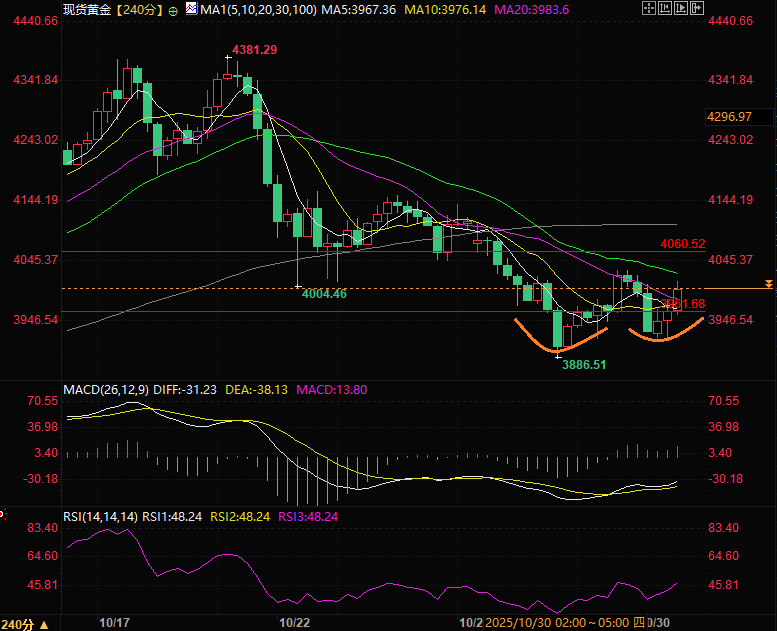Why did gold short sellers retreat so quickly after the Fed's hawkish rate cut?
2025-10-30 18:01:40

The U.S. Federal Reserve announced on Wednesday a 25-basis-point cut to its benchmark interest rate, in line with market expectations. This was the second rate cut this year. The decision was opposed by two policymakers: Federal Reserve Governor Stephen Milan advocated for a larger rate cut, while Kansas City Federal Reserve Bank President Jeffrey Schmid preferred to maintain the current interest rate level due to concerns about inflation.
The US Federal Reserve also stated that it would stop shrinking its balance sheet as early as December, marking the formal end of its quantitative tightening program. However, at the press conference following the meeting, Federal Reserve Chairman Jerome Powell explicitly refuted market expectations of another rate cut in December.
Powell acknowledged that committee members had observed risks to the labor market, but also noted uncertainty surrounding further interest rate adjustments without a full grasp of the economic fundamentals. This statement may curb aggressive short-selling of the dollar and limit meaningful appreciation of gold, a non-interest-bearing asset.
This article summarizes recent developments.
The Federal Reserve's hawkish rate cut, coupled with the exit from QT, presents an overall dovish tone.
The Fed's dovish rate cut but announcement of ending QT (quantitative tightening) still maintains an accommodative tone. Although the Fed's comments weakened the December rate cut and put downward pressure on gold prices, the mention of a possible QE in the Fed's remarks also left room for upward speculation on gold prices. After all, QE would release liquidity, which could weaken the dollar and raise inflation.
However, if subsequent US data and the attitude of Federal Reserve officials shift to a dovish stance, it will provide support for gold prices. Traders are currently focusing on speeches by key members of the Federal Open Market Committee (FOMC) to capture key clues driving market movements.
Following the high-level meeting, gold short sellers took profits in a concentrated manner.
Following the meeting between the US and China, the US president stated that issues related to soybeans and rare earths had been resolved, and market concerns about trade subsided, leading some short sellers in gold to take profits, causing gold to rebound.
Market expectations of a positive outcome from the high-level meeting between the US and China suppressed safe-haven buying of gold. However, as the meeting concluded, gold short sellers took profits, while safe-haven buying increased. Therefore, before confirming that the recent sharp correction that began after hitting a historical high earlier this month has ended and before positioning for further upward movement, it is more prudent to wait for strong follow-up buying signals.
The continued US government shutdown has led to a return of safe-haven buying to gold.
The deadlock in Congress over a Republican-backed appropriations bill has sealed the fourth week of the government shutdown, fueling market concerns about the U.S. economic outlook. This factor pushed the dollar back from its post-FOMC meeting highs and boosted safe-haven demand for gold during Thursday's Asian trading session.
Traders are currently awaiting speeches from several key FOMC members later in the North American session for further clues about the future path of interest rate cuts. This policy outlook will play a crucial role in influencing the short-term price movement of the US dollar and will provide directional impetus for the gold/dollar exchange rate.
Technical Analysis:
The four-hour chart for spot gold shows that after failing to break the previous low during the second dip in the morning session, spot gold began to rebound. If the price can hold above 4,000 points, it may form a double bottom pattern. If it breaks through the double bottom pattern, the price may have the opportunity to attack the heavily oversold area of 4,150.

(Spot gold 4-hour chart)
3962 is the nearest support level. If it fails to hold, the gold price will likely retest the previous low of 3886, followed by the 50% Fibonacci support level of 3750.

(Spot gold daily chart, source: FX678)
At 17:53 Beijing time, spot gold was trading at $4,007 per ounce.
- Risk Warning and Disclaimer
- The market involves risk, and trading may not be suitable for all investors. This article is for reference only and does not constitute personal investment advice, nor does it take into account certain users’ specific investment objectives, financial situation, or other needs. Any investment decisions made based on this information are at your own risk.





















